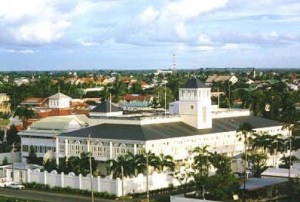
While numerous federal agencies took an interest in Peoples Temple following the deaths in Jonestown, the State Department – and most particularly, the U.S. Embassy in Georgetown, Guyana – had the greatest contact with the organization between 1974 and November 1978, the period of Jonestown’s existence.
Much of that contact stemmed from the fact that the Embassy had responsibilities for the “whereabouts and welfare” of individual residents of Jonestown, not only as it responded to queries from relatives in the U.S., but also at it provided consular services for the people themselves, almost all of whom arrived in Guyana as American citizens and remained so until their deaths.
The agency’s involvement generated more than 6000 pages of documents. In 1981, responding to a request under the Freedom of Information Act from Rebecca Moore and Fielding McGehee, who eventually became the managers of this website, State released about 5700 pages. The majority of the documents consisted of cables between Georgetown and Washington, dating from 1974 until 1981, with most of them from November and December of 1978 and early 1979. In addition to that initial 1981 release, the State Department later released 350 pages under FOIA of agency records on the child custody battle over John Victor Stoen.
It should be noted that many of the texts for the cables included in the pages below were provided by the Wikileaks site, which was discovered to be defunct in late 2022. This is especially true for cables for which there is no corresponding pdf or which were heavily redacted. For more discussion of Wikileaks’ collapse, click here.
The State Department Cables
1974-1977
January – November 1978
The Leo Ryan Trip
November 18, 1978
The First Week – November 19-November 25, 1978
The Second Week – November 26-December 2, 1978
December 1978
January – December 1979
1980-1981
There were thousands of other pages beyond the cables in the State Department’s possession as well. Several hundred of them have been transcribed, including:
The Stoens, the U.S. Embassy, the State Department, and Congress
Prior to the deaths, the Embassy had scores of interactions with Peoples Temple. Most of them came in the form of periodic visits to Jonestown by consular officers, who, among other responsibilities, conducted “Whereabouts and Welfare” checks on Jonestown residents on behalf of their relatives back in the US. The Embassy was also deeply involved in balancing the efforts of Timothy and Grace Stoen to regain custody over John Victor Stoen, with its responsibility to remain a neutral party in all disputes concerning American citizens living in Guyana. Following November 18, the State Department and its embassy was overwhelmed with its work to repatriate the bodies from Jonestown, to field hundreds of queries from families, the press, and Congress, and to maintain America’s relationship with the country of Guyana itself.
Many of the cables – especially those in the 1981 release – contained information which was deleted under an exemption in the Freedom of Information Act. The most commonly-used exemptions by State are:
b(1) = information the release of which would jeopardize national security
b(6) = information the release of which would violate an individual’s privacy
In 2014, the State Department released thousands of agency files as part of a general declassification review, including hundreds of cables related to Peoples Temple. They didn’t become widely available to the public, however, until 2015 and 2016, when Wikileaks put them online. While the resulting record was neither official nor complete – there are scores of cables that the State Department continues to withhold and that Wikileaks didn’t access – the texts that Wikileaks posted are accurate.